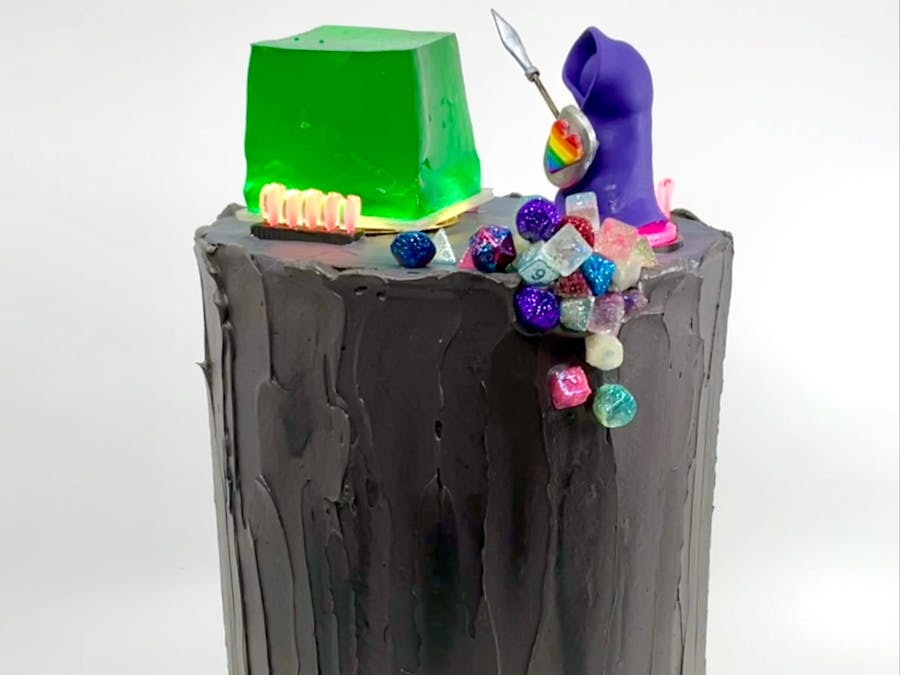I make bespoke interactive cakes.
That means I make edible celebration cakes that also incorporate some form of motion or lights or sounds.
Here's one I made earlier:
A birthday party for a 14 year old D&D enthusiast.
The logistics:10 teenagers at a bowling alley. Lots of background music and noise. Very dim lighting. Kids will have plenty of down time between bowling turns. Cake to be transported via Taxi over speedbumps to get to the venue. A power socket is available.
The Idea:A ‘playable’ cake that uses the dice rolling mechanics of D&D to win an encounter. The birthday boy typically plays D&D as a cleric, so I wanted to have a cleric face off against some creature type enemy.
A dragon was the obvious first choice, but the mechanics of building an edible dragon with moving parts on a very small scale became too complex. I moved to a gelatinous cube instead which proved to be an absolutely delightful solution.
The game consists of two figures, each with 5 hearts. When the button is pressed rainbow lights swirl under each character, symbolizing a dice roll. The ‘dice rolls’ are completely random so the winner is always random. The loser of each roll loses a life heart. The loser of the game is the first to lose all 5 hearts. The winner’s character does a little attack motion to symbolize their win. The cleric swishes back and forth with his spear. The gelatinous cube wobbles menacingly. The game re-sets for unlimited plays.
The build:I used isomalt + edible glitter + flavoring extracts to create these tiny little edible D&D dice.
Because I’m not yet completely insane, I purchased a silicone mold from an Etsy seller rather than making one myself.
The gelatinous cube was made from lime Jello using the Jigglers recipe. A hot knife helped to make the edges smooth.
The cleric was made from fondant, with a little painted toothpick to form the base of his spear.
Each figure rests on top of a 3D printed platform attached to a servo motor. The platforms float over neopixel rings. In order to have the lights visible, the platforms are made from transparent PLA.
The life hearts are 3mm laser cut and etched acrylic sitting over mini skinny neopixel strips.
All of the components are housed inside a 3D printed layer, that sits on top of 6 layers of Funfetti cake and vanilla Swiss meringue buttercream icing.
I use Tinkercad to design my component layers and all 3D printed parts are made of PLA, washed prior to assembly, then covered in cling film before being placed on a cake. I cover the component layer in fondant or icing, or sometimes both, to make the component layer blend with the rest of the cake. A (washed and covered) PVC pipe runs from the component layer, through to the laser cut wooden base to allow access to the button wires and power cord.
This project was written in Circuit Python and based on the ubiquitous dice rolling game that's a fairly standard beginner lesson in Python. I also used ChatGPT to review the code and make sense of ordering some of the functions.
Because it was what I had available, I used a an Adafruit Circuit Playground Bluefruit for this build. A better board, just on form factor alone, would have been an Adafruit Feather M0 (or similar) since I was only running two Neopixel rings, two tiny neopixel strips and two servos.
Initially, I thought I’d use a vibration motor to wiggle the Cube. But, as I tested, I found that the Jello just absorbed the vibration completely, so it looked like no movement at all. A micro-servo, sweeping back and forth over 30 degrees gave the perfect amount of wobble.
The cleric also sits on a servo and sweeps over 90 degrees. He is attached to his base with a blob of fondant and some piping gel. The jello cube has enough weight and friction on its own to sit unaided.
I considered using sounds to make each of stage of the game play more clearly delineated - 1 noise for rolling, 1 noise for a ‘hit’, and winning noises for the swishing/wobbling - but the bowling alley was going to be very loud, so I went with only lights as indicators instead. I also considered using a small display of some sort to make the dice rolling more obvious, but a display would have overwhelmed an already crowded cake top.
Ultimately, the party kids were super happy with the cake and had no trouble understanding the basic game mechanics.
My next challenge is to create a swappable base with integrated electrical connections so I never have to fumble with running power wires through the center of a cake again.









_t9PF3orMPd.png?auto=compress%2Cformat&w=40&h=40&fit=fillmax&bg=fff&dpr=2)


Comments
Please log in or sign up to comment.